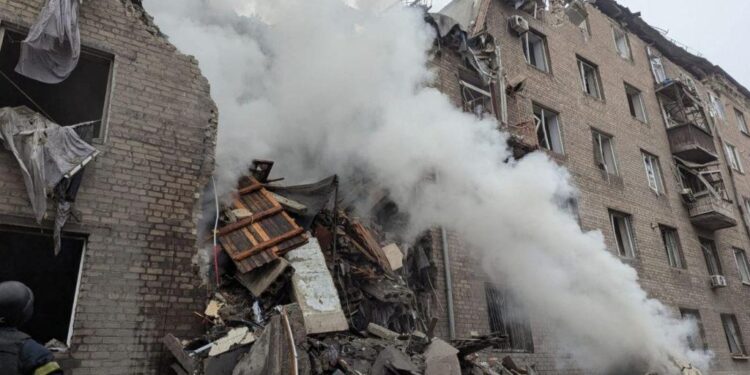Russian missile and drone strikes have resulted in the deaths of four people in Ukraine, escalating the ongoing conflict in the region. In response to the intensified attacks, Ukrainian President Volodymyr Zelenskyy has urgently called for enhanced air defense support to counter the growing threat. The latest assaults highlight the increasing use of advanced weaponry in the conflict and underscore Kyiv’s urgent appeals for international assistance.
Russian Missile and Drone Strikes Escalate Casualties in Ukraine Amid Ongoing Conflict
Amid the ongoing conflict, Ukraine has suffered a deadly surge in missile and drone attacks, resulting in the deaths of at least four civilians. These targeted strikes have primarily focused on critical infrastructure, exacerbating the humanitarian crisis and disrupting daily life for millions. Ukrainian officials report increasing difficulty in defending against waves of advanced weaponry, which has prompted President Volodymyr Zelenskyy to urgently call for enhanced international air defense support. The latest attacks mark a worrying escalation, as drones and missiles strike both urban centers and strategic military sites, intensifying the battle for control across eastern regions.
- Casualties Reported: 4 dead, multiple wounded
- Target Areas: Residential districts, energy facilities
- Defense Challenges: Limited air defense systems amid relentless strikes
- International Response: Calls for stronger aid and supply of air defense weaponry
| Date | Location | Type of Attack | Impact |
|---|---|---|---|
| April 22, 2024 | Donetsk | Missile Strike | 3 fatalities, power outage |
| April 23, 2024 | Kharkiv | Drone Attack | Military depot damaged, no casualties |
Experts emphasize that the current intensity of attacks represents not only a military escalation but also a strategic effort to destabilize Ukrainian infrastructure and morale. The repeated use of drones has showcased Russia’s expanding reliance on unmanned systems to evade traditional air defense networks. As both sides brace for further confrontations, the international community faces mounting pressure to deliver advanced air defense solutions and humanitarian aid to mitigate the escalating toll.
Zelenskyy Urges International Community to Strengthen Air Defense Capabilities
In the wake of deadly missile and drone assaults across several Ukrainian cities, President Volodymyr Zelenskyy urgently called on global partners to bolster the nation’s air defense infrastructure. These attacks, which resulted in the deaths of four civilians, signal an intensification of aerial aggression from Russian forces. Zelenskyy emphasized that without enhanced defensive measures, Ukraine’s civilian population and critical infrastructure remain exceptionally vulnerable to further strikes. The president specifically highlighted the importance of acquiring advanced missile interception systems and expanding drone countermeasures to mitigate ongoing threats.
Experts note that the current Ukrainian air defense network is stretched thin, struggling to keep pace with the evolving tactics and sheer volume of Russian attacks. To illustrate the pressing needs, the following table summarizes key areas where international assistance is most urgent:
| Capability | Description | Priority Level |
|---|---|---|
| Missile Defense Systems | Advanced interceptors to neutralize ballistic and cruise missiles | High |
| Drone Detection Technology | Radar and automated tracking for small to medium UAVs | Medium |
| Electronic Warfare Equipment | Jamming devices to disrupt enemy drone communications | High |
| Training & Maintenance | Support for personnel to operate and maintain complex systems | Medium |
Experts Recommend Enhanced Surveillance and Integrated Defense Systems to Counter Aerial Threats
In response to the escalating wave of missile and drone assaults across Ukraine, defense analysts emphasize the urgent necessity for advanced aerial monitoring technologies paired with comprehensive defense frameworks. Enhanced radar systems capable of detecting low-flying, stealthy drones alongside sophisticated missile interception mechanisms can substantially mitigate the risk of civilian casualties and infrastructure damage. Experts argue that piecemeal solutions fall short against the multipronged nature of modern aerial threats, pushing for a cohesive integration of electronic warfare, artificial intelligence, and real-time data sharing across military branches.
Key strategic recommendations include:
- Deployment of next-generation multi-sensor surveillance networks for continuous 360-degree airspace monitoring
- Implementation of layered missile defense systems combining kinetic interceptors with directed energy weapons
- Integration of AI-driven threat analysis to accelerate decision-making and response times
- Enhanced interoperability between ground forces, air units, and civilian air defense agencies
| System Component | Function | Impact |
|---|---|---|
| Advanced Radar | Detects low-RCS drones and missiles | Early threat identification |
| AI Threat Analysis | Processes incoming data for threat prioritization | Faster engagement decisions |
| Integrated Command Network | Coordinates multiple defense assets | Unified, adaptive response |
In Conclusion
As the conflict in Ukraine intensifies, the recent missile and drone attacks marking over a dozen casualties underscore the pressing need for enhanced air defense capabilities. President Zelenskyy’s urgent appeals reflect the mounting challenges faced by Ukrainian forces in protecting civilian populations amid ongoing hostilities. The international community continues to watch closely, weighing responses as the situation evolves.
















